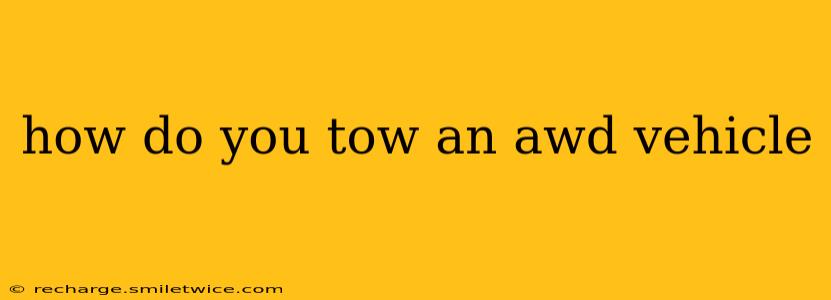Towing an all-wheel-drive (AWD) vehicle might seem daunting, but understanding the proper techniques ensures a safe and damage-free process. Unlike two-wheel-drive vehicles, AWD systems have specific requirements that must be met to prevent costly repairs. This guide will walk you through the process, addressing common concerns and misconceptions.
What Makes Towing an AWD Vehicle Different?
The key difference lies in the AWD system itself. These systems often utilize a transfer case, differentials, and a complex arrangement of driveshafts connecting the engine to all four wheels. Towing an AWD vehicle improperly can damage these components, leading to expensive repairs. The method of towing depends on the type of AWD system and the vehicle's manufacturer recommendations. Always consult your owner's manual – it's the ultimate authority for your specific vehicle.
How to Determine the Correct Towing Method
Your owner's manual will specify the recommended towing method for your AWD vehicle. Generally, you'll find one of the following recommendations:
-
Flatbed Towing: This is the safest and most recommended method for towing most AWD vehicles. The entire vehicle is lifted onto a flatbed tow truck, eliminating any stress on the drivetrain. This prevents damage to the transmission, transfer case, and other components.
-
Wheel-Lift Towing: In some cases, wheel-lift towing might be acceptable, but only if the manufacturer explicitly allows it and under strict conditions. This method lifts only the front or rear wheels, leaving the other wheels on the ground. Improper wheel-lift towing can severely damage the AWD system.
-
Dolly Towing: This method involves placing a dolly under the rear wheels of the vehicle. Again, check your owner's manual; this method may be acceptable for some AWD vehicles, but it's less common than flatbed towing.
Crucially, exceeding the maximum towing capacity specified in your owner's manual can cause significant damage and void warranties.
H2: What are the risks of towing an AWD vehicle incorrectly?
Towing an AWD vehicle incorrectly carries several risks, including:
- Transmission Damage: Forcing the drivetrain to rotate while towing can lead to significant internal transmission damage.
- Transfer Case Damage: The transfer case, responsible for distributing power between the axles, is particularly vulnerable to damage during improper towing.
- Driveshaft Damage: The driveshafts can be damaged by twisting and bending forces during improper towing.
- Differential Damage: Differentials can be damaged if the wheels are rotating during towing.
- Voiding Warranty: Incorrect towing procedures often void vehicle warranties, leaving you responsible for costly repairs.
H2: Can I tow my AWD vehicle in neutral?
This is a common question, and the answer is nuanced. While putting the vehicle in neutral might seem like a good idea, it's often not recommended for AWD vehicles, especially during wheel-lift towing. Even in neutral, some components of the AWD system might still be engaged, leading to potential damage. Always check your owner's manual; the safest option is typically flatbed towing.
H2: What if my owner's manual is unavailable?
If you can't find your owner's manual, the next best step is to contact your vehicle's manufacturer directly. Their customer service department should be able to provide the correct towing instructions for your specific make, model, and year. You can usually find their contact information on their official website.
H2: What's the best way to ensure my AWD vehicle is towed safely?
The absolute best way to ensure your AWD vehicle's safety during towing is to use a flatbed tow truck. This method minimizes the risk of damage to the AWD system and gives you peace of mind.
Conclusion
Towing an AWD vehicle requires careful attention to detail. Always prioritize consulting your owner's manual and, when in doubt, choose flatbed towing to ensure the safety and longevity of your vehicle's drivetrain. Ignoring these guidelines can lead to costly repairs and invalidate warranties. Remember, prevention is always better than cure when it comes to towing your AWD vehicle.
